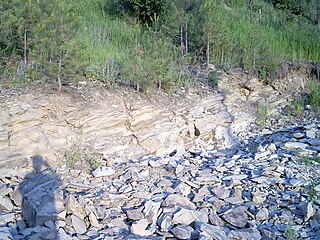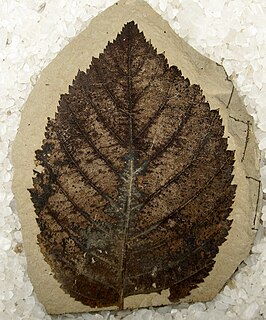
Neviusia alabamensis, the Alabama snow-wreath, is a small shrub which is native to the Southeastern United States.

Trochodendron nastae is an extinct species of flowering plant in the family Trochodendraceae known from fossil leaves found in the early Eocene Ypresian stage Klondike Mountain Formation deposits of northern Washington state. T. nastae is one of the oldest members of the genus Trochodendron, which includes the living species T. aralioides, native to Japan, southern Korea and Taiwan and the coeval extinct species T. drachukii from the McAbee Fossil Beds near Cache Creek, British Columbia.
Trochodendron drachukii is an extinct species of flowering plants in the family Trochodendraceae known from a fossil fruiting structure found in the early Ypresian age Eocene fossils found in British Columbia, Canada. T. drachukii is one of the oldest members of the genus Trochodendron, which includes the living species T. aralioides, native to Japan, southern Korea and Taiwan and the coeval extinct species T. nastae from Washington state, United States.
Neviusia dunthornei is an extinct species of flowering plants in the family Rosaceae. The species is solely known from the early Eocene, Ypresian stage, Allenby Formation Lacustrine deposits near the town of Princeton, British Columbia.
Neoephemera antiqua is an extinct species of mayfly in the family Neoephemeridae that is known from early Eocene, Ypresian stage, lake deposits near the small community of Republic in Ferry County, Washington, USA.

The Klondike Mountain Formation is an Early Eocene (Ypresian) geological formation located in the northeast central area of Washington state. The formation, named for the type location designated in 1962, Klondike Mountain north of Republic, Washington, is composed of volcanic rocks in the upper unit and volcanics plus lacustrine (lakebed) sedimentation in which a lagerstätte with exceptionally well-preserved plant and insect fossils has been found, along with fossil epithermal hot springs.

The McAbee Fossil Beds is a Heritage Site that protects an Eocene Epoch fossil locality east of Cache Creek, British Columbia, Canada, just north of and visible from Provincial Highway 97 / the Trans-Canada Highway. The McAbee Fossil Beds, comprising 548.23 hectares, were officially designated a Provincial Heritage Site under British Columbia's Heritage Conservation Act on July 19, 2012. The site is part of an old lake bed which was deposited about 52 million years ago and is internationally recognised for the diversity of plant, insect, and fish fossils found there. Similar fossil beds in Eocene lake sediments, also known for their well preserved plant, insect and fish fossils, are found at Driftwood Canyon Provincial Park near Smithers in northern British Columbia, on the Horsefly River near Quesnel in central British Columbia, and at Republic in Washington, United States. The Princeton Chert fossil beds in southern British Columbia are also Eocene, but primarily preserve an aquatic plant community. A recent review of the early Eocene fossil sites from the interior of British Columbia discusses the history of paleobotanical research at McAbee, the Princeton Chert, Driftwood Canyon, and related Eocene fossil sites such as at Republic.

The Allenby formation is a sedimentary rock formation deposited during the early to early Middle Eocene. It consists of conglomerates, sandstones with interbedded with shales and coal. The coal seams contain an abundance of insect, fish and plant fossils, known from the shales since 1877 but best known from the Princeton Chert.

Rhus malloryi is an extinct species of flowering plant in the sumac family Anacardiaceae. The species is known from fossil leaves found in the early Eocene deposits of northern Washington state, United States. The species was first described from a series of isolated fossil leaves in shale. R. malloryi is one of four sumac species to be described from the Klondike Mountain Formation, and forms a hybrid complex with the other three species.

Tsukada is an extinct genus of flowering plant in the family Nyssaceae related to the modern "dove-tree", Davidia involucrata, containing the single species Tsukada davidiifolia. The genus is known from fossil leaves found in the early Eocene deposits of northern Washington state, United States and a similar aged formation in British Columbia, Canada.

Nuphar carlquistii is an extinct species of flowering plant in the family Nymphaeaceae related to the modern spatterdock, Nuphar advena. The species is known from fossil seeds and fruits found in the early Eocene deposits of northern Washington state, United States, and a similar aged formation in British Columbia, Canada.

Betula leopoldae is an extinct species of birch in the family Betulaceae. The species is known from fossil leaves, catkins, and inflorescences found in the early Eocene deposits of northern Washington state, United States, and similar aged formations in British Columbia, Canada. The species is placed as basal in Betula, either as a stem group species, or an early divergent species.

Rhus boothillensis is an extinct species of flowering plant in the sumac family Anacardiaceae. The species is known from fossil leaves found in the early Eocene deposits of northern Washington State, United States. The species was first described from fossil leaves found in the Klondike Mountain Formation. Rhus boothillensis likely hybridized with the other Klondike Mountain formation sumac species Rhus garwellii, Rhus malloryi, and Rhus republicensis.

Rhus garwellii is an extinct species of flowering plant in the sumac family Anacardiaceae. The species is known from fossil leaves found in the early Eocene deposits of northern Washington State, United States. The species was first described from fossil leaves found in the Klondike Mountain Formation. R. garwellii likely hybridized with the other Klondike Mountain formation sumac species R. boothillensis, R. malloryi, and R. republicensis.
Rhus republicensis is an extinct species of flowering plant in the sumac family, Anacardiaceae. The species is known from fossil leaves found in the early Eocene deposits of northern Washington state in the United States. The species was first described from fossil leaves found in the Klondike Mountain Formation. R. republicensis likely hybridized with the other Klondike Mountain formation sumac species Rhus boothillensis, Rhus garwellii, and Rhus malloryi.

Pentacentron is an extinct genus of flowering plant in the family Trochodendraceae, consisting of the single species Pentacentron sternhartae. The genus is known from fossil fruits found in the early Eocene deposits of northern Washington state, United States. P. sternhartae are possibly the fruits belonging to the extinct trochodendraceous leaves Tetracentron hopkinsii.

Tetracentron hopkinsii is an extinct species of flowering plant in the family Trochodendraceae. The species is known from fossil leaves found in the early Eocene deposits of northern Washington state, United States and south Central British Columbia. The species was first described from fossil leaves found in the Allenby Formation. T. hopkinsii are possibly the leaves belonging to the extinct trochodendraceous fruits Pentacentron sternhartae.
Paraconcavistylon is an extinct genus of flowering plant in the family Trochodendraceae comprises a single species, Paraconcavistylon wehrii. The genus is known from fossil fruits and leaves found in the early Eocene deposits of northern Washington state, United States, and southern British Columbia, Canada. The species was initially described as a member of the related extinct genus Concavistylon as "Concavistylon" wehrii, but subsequently moved to the new genus Paraconcavistylon in 2020 after additional study.

Comptonia columbiana is an extinct species of sweet fern in the flowering plant family Myricaceae. The species is known from fossil leaves found in the early Eocene deposits of central to southern British Columbia, Canada plus northern Washington state, United States, and, tentatively, the late Eocene of Southern Idaho and Earliest Oligocene of Oregon, United States.














